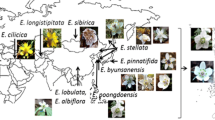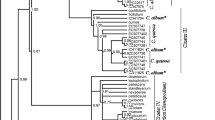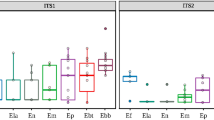Abstract
Internal transcribed spacer (ITS) is used as a molecular marker in most phylogenetical analyses in Boraginaceae, an unplaced group in the current angiosperm phylogeny. However, there is no knowledge on intra-individual polymorphism of ITS in Boraginaceae. Difficulties in PCR and sequencing of ITS in Pulmonaria species mentioned in the literature may be seen as indirect evidence of intra-individual polymorphism. This study aims to detect intra-individual polymorphism of ITS1–5.8S–ITS2 in rare species Pulmonaria angustifolia L. and common species Pulmonaria obscura Dumort. Cloning of ITS sequences of P. angustifolia, P. obscura and putative hybrid specimens from mixed population showed intra-individual polymorphism of ITS1–5.8S–ITS2 in all specimens, whereas most of them also contained pseudogenic sequences. Intra-individual sequence divergence of ITS1 and ITS2 spacers was similar in the P. angustifolia and mixed population and significantly higher than in P. obscura. P. angustifolia specimens had nucleotide polymorphisms characteristic to both P. angustifolia and P. obscura and part of P. angustifolia sequences clustered into mostly P. obscura clade on the neighbour-joining trees based on ITS1 sequence and ITS2 sequence and structure data. These results suggest a hybrid origin of all P. angustifolia populations studied. Thus, outbreeding depression is a likely explanation for the decline in populations near the northern border of distribution area of rare species P. angustifolia. Hybrid origin of the whole P. angustifolia is also probable; the central population from Poland showed a similar pattern of polymorphism as distribution edge populations.



Similar content being viewed by others
References
Alvarez I, Wendel JF (2003) Ribosomal ITS sequences and plant phylogenetic inference. Mol Phylogen Evol 29(3):417–434. doi:10.1016/s1055-7903(03)00208-2
Bailey CD, Carr TG, Harris SA, Hughes CE (2003) Characterization of angiosperm nrDNA polymorphism, paralogy, and pseudogenes. Mol Phylogen Evol 29(3):435–455. doi:10.1016/j.ympev.2003.08.021
Bigazzi M, Selvi F (2001) Karyotype morphology and cytogeography in Brunnera and Cynoglottis (Boraginaceae). Bot J Linn Soc 136(4):365–378. doi:10.1111/j.1095-8339.2001.tb00580.x
Calonje M, Martín-Bravo S, Dobeš C, Gong W, Jordon-Thaden I, Kiefer C, Kiefer M, Paule J, Schmickl R, Koch M (2009) Non-coding nuclear DNA markers in phylogenetic reconstruction. Pl Syst Evol 282(3–4):257–280. doi:10.1007/s00606-008-0031-1
Cecchi L, Coppi A, Selvi F (2011) Evolutionary dynamics of serpentine adaptation in Onosma (Boraginaceae) as revealed by ITS sequence data. Pl Syst Evol 297(3–4):185–199. doi:10.1007/s00606-011-0506-3
Góralski G, Lubczyńska P, Joachimiak AJ (2009) Chromosome Number Database. http://chromosomes.binoz.uj.edu.pl. Accessed 04 May 2014
Cohen JI (2013) A phylogenetic analysis of morphological and molecular characters of Boraginaceae: evolutionary relationships, taxonomy, and patterns of character evolution. Cladistics. doi:10.1111/cla.12036
Coleman AW (2003) ITS2 is a double-edged tool for eukaryote evolutionary comparisons. Trends Genet 19(7):370–375. doi:10.1016/s0168-952503)00118-5
Coleman AW (2007) Pan-eukaryote ITS2 homologies revealed by RNA secondary structure. Nucleic Acids Res 35(10):3322–3329. doi:10.1093/nar/gkm233
Coleman AW (2009) Is there a molecular key to the level of “biological species” in eukaryotes? A DNA guide. Mol Phylogen Evol 50(1):197–203. doi:10.1016/j.ympev.2008.10.008
Conesa MA, Mus M, Rossello JA (2008) Hybridization between insular endemic and widespread species of Viola in non-disturbed environments assessed by nuclear ribosomal and cpDNA sequences. Pl Syst Evol 273(3–4):169–177. doi:10.1007/s00606-008-0006-2
Coppi A, Selvi F, Bigazzi M (2006) Chromosome studies in Mediterranean species of Boraginaceae. Fl Medit 16:253–274
Dong LN, Wortley AH, Wang H, Li DZ, Lu L (2011) Efficiency of DNA barcodes for species delimitation: a case in Pterygiella Oliv. (Orobanchaceae). J Syst Evol 49(3):189-202. doi:10.1111/j.1759-6831.2011.00124.x
Doyle JJ, Doyle JL (1987) A rapid DNA isolation procedure for small quantites of fresh leaf tissue. Phytochemical Bulletin 19:11–15
Elder JF, Turner BJ (1995) Concerted evolution of repetitive DNA-sequences in Eucaryotes. Q Rev Biol 70(3):297–320
Feliner GN, Rossello JA (2007) Better the devil you know? Guidelines for insightful utilization of nrDNA ITS in species-level evolutionary studies in plants. Mol Phylogen Evol 44(2):911–919. doi:10.1016/j.ympev.2007.01.013
Gao T, Yao H, Song JY, Zhu YJ, Liu C, Chen SL (2010) Evaluating the feasibility of using candidate DNA barcodes in discriminating species of the large Asteraceae family. BMC Evol Biol 10. doi:10.1186/1471-2148-10-324
Goertzen LR, Cannone JJ, Gutell RR, Jansen RK (2003) ITS secondary structure derived from comparative analysis: implications for sequence alignment and phylogeny of the Asteraceae. Mol Phylogen Evol 29(2):216–234. doi:10.1016/s1055-7903(03)00094-0
Gottschling M, Hilger HH, Wolf M, Diane N (2001) Secondary structure of the ITS1 transcript and its application in a reconstruction of the phylogeny of Boraginales. Plant Biol 3(6):629–636. doi:10.1055/s-2001-19371
Hall TA (1999) BioEdit: a user-friendly biological sequence alignment editor and analysis program for Windows 95/98/NT. In: Nucleic acids symposium series, pp 95–98
Harpke D, Peterson A (2008a) 5.8S motifs for the identification of pseudogenic ITS regions. Botany-Botanique 86(3):300–305. doi:10.1139/b07-134
Harpke D, Peterson A (2008b) Extensive 5.8S nrDNA polymorphism in Mammillaria (Cactaceae) with special reference to the identification of pseudogenic internal transcribed spacer regions. J Plant Res 121(3):261–270. doi:10.1007/s10265-008-0156-x
Hartmann S, Nason JD, Bhattacharya D (2001) Extensive ribosomal DNA genic variation in the columnar cactus Lophocereus. J Mol Evol 53(2):124–134
Hershkovitz MA, Zimmer EA (1996) Conservation patterns in angiosperm rDNA ITS2 sequences. Nucleic Acids Res 24(15):2857–2867. doi:10.1093/nar/24.15.2857
Hilger HH, Selvi F, Papini A, Bigazzi M (2004) Molecular systematics of Boraginaceae tribe boragineae based on ITS1 and trnL sequences, with special reference to Anchusa s.l. Ann Bot (Oxford) 94(2):201–212. doi:10.1093/aob/mch132
Hribova E, Cizkova J, Christelova P, Taudien S, de Langhe E, Dolezel J (2011) The ITS1–5.8S–ITS2 sequence region in the Musaceae: structure, diversity and use in molecular phylogeny. PLoS ONE 6(3):e17863
Hultén E, Fries M (eds) (1986) Atlas of north European vascular plants north of the Tropic of Cancer, vols I–III. Koeltz Scientific Books Königstein, Germany
Jobes DV, Thien LB (1997) A conserved motif in the 5.8S ribosomal RNA (rRNA) gene is a useful diagnostic marker for plant internal transcribed spacer (ITS) sequences. Plant Mol Biol Rep 15(4):326–334. doi:10.1023/a:1007462330699
Kirchner DE (2004) Molekulare Phylogenie und Biogeographie der Gattung Pulmonaria L. (Boraginaceae). Verlag Mainz, Aachen
Klotz S, Kühn I, Durka W (Hrsg.) (2002) BIOLFLOR—Eine Datenbank zu biologisch-ökologischen Merkmalen der Gefäßpflanzen in Deutschland. Schriftenreihe für Vegetationskunde 38
Koch MA, Dobeš C, Mitchell-Olds T (2003) Multiple hybrid formation in natural populations: concerted evolution of the internal transcribed spacer of nuclear ribosomal DNA (ITS) in North American Arabis divaricarpa (Brassicaceae). Mol Biol Evol 20(3):338–350. doi:10.1093/molbev/msg046
Koetschan C, Hackl T, Muller T, Wolf M, Forster F, Schultz J (2012) ITS2 Database IV: interactive taxon sampling for internal transcribed spacer 2 based phylogenies. Mol Phylogen Evol 63(3):585–588. doi:10.1016/j.ympev.2012.01.026
Kovarik A, Pires JC, Leitch AR, Lim KY, Sherwood AM, Matyasek R, Rocca J, Soltis DE, Soltis PS (2005) Rapid concerted evolution of nuclear ribosomal DNA in two tragopogon allopolyploids of recent and recurrent origin. Genetics 169(2):931–944. doi:10.1534/genetics.104.032839
Kukk T, Kull T (2005) Atlas of the Estonian Flora. Institute of Agricultural and Environmental Sciences of the Estonian University of Life Sciences, Tartu
Langstrom E, Chase MW (2002) Tribes of Boraginoideae (Boraginaceae) and placement of Antiphytum, Echiochilon, Ogastemma and Sericostoma: a phylogenetic analysis based on atpB plastid DNA sequence data. Pl Syst Evol 234(1–4):137–153. doi:10.1007/s00606-002-0195-z
Larkin MA, Blackshields G, Brown NP, Chenna R, McGettigan PA, McWilliam H, Valentin F, Wallace IM, Wilm A, Lopez R, Thompson JD, Gibson TJ, Higgins DG (2007) Clustal W and clustal X version 2.0. Bioinformatics 23(21):2947–2948. doi:10.1093/bioinformatics/btm404
Lazdauskaite Ž, Viljasoo L, Abele G (1996) Pulmonaria. In: Kuusk V, Tabaka L, Jankeviciene R (ed) Flora of the Baltic countries, vol 2. Estonian Academy of Sciences Institute of Zoology and Botany, Tartu, pp 276–277
Librado P, Rozas J (2009) DnaSP v5: a software for comprehensive analysis of DNA polymorphism data. Bioinformatics 25(11):1451–1452. doi:10.1093/bioinformatics/btp187
Liston A, Robinson WA, Oliphant JM, AlvarezBuylla ER (1996) Length variation in the nuclear ribosomal DNA internal transcribed spacer region of non-flowering seed plants. Syst Bot 21(2):109–120. doi:10.2307/2419742
Liu JS, Schardl CL (1994) A conserved sequence in internal transcribed spacer-1 of plant nuclear ribosomal RNA genes. Plant Mol Biol 26(2):775–778. doi:10.1007/bf00013763
Mai JC, Coleman AW (1997) The internal transcribed spacer 2 exhibits a common secondary structure in green algae and flowering plants. J Mol Evol 44(3):258–271. doi:10.1007/pl00006143
Mayol M, Rossello JA (2001) Why nuclear ribosomal DNA spacers (ITS) tell different stories in Quercus. Mol Phylogen Evol 19(2):167–176. doi:10.1006/mpev.2001.0934
Mengoni A, Selvi F, Cusimano N, Galardi F, Gonnelli C (2006) Genetic diversity inferred from AFLP fingerprinting in populations of Onosma echioides (Boraginaceae) from serpentine and calcareous soils. Pl Biosyst 140(2):211–219. doi:10.1080/11263500600756660
Muller T, Philippi N, Dandekar T, Schultz J, Wolf M (2007) Distinguishing species. RNA-Publ RNA Soc 13(9):1469–1472. doi:10.1261/rna.617107
Murillo J, Ruiz E, Landrum LR, Stuessy TF, Barfuss MHJ (2012) Phylogenetic relationships in Myrceugenia (Myrtaceae) based on plastid and nuclear DNA sequences. Mol Phylogen Evol 62(2):764–776. doi:10.1016/j.ympev.2011.11.021
Nei M (1987) Molecular evolutionary genetics. Columbia University Press, New York
Poczai P, Hyvonen J (2010) Nuclear ribosomal spacer regions in plant phylogenetics: problems and prospects. Mol Biol Rep 37(4):1897–1912. doi:10.1007/s11033-009-9630-3
Queiroz CdS, de Carvalho Batista FR, de Oliveira LO (2011) Evolution of the 5.8S nrDNA gene and internal transcribed spacers in Carapichea ipecacuanha (Rubiaceae) within a phylogeographic context. Mol Phylogen Evol 59(2):293–302. doi:10.1016/j.ympev.2011.01.013
Reier U, Tuvi EL, Partel M, Kalamees R, Zobel M (2005) Threatened herbaceous species dependent on moderate forest disturbances: a neglected target for ecosystem-based silviculture. Scand J Forest Res 20:145–152. doi:10.1080/14004080510042128
Ruhl MW, Wolf M, Jenkins TM (2010) Compensatory base changes illuminate morphologically difficult taxonomy. Mol Phylogen Evol 54(2):664–669. doi:10.1016/j.ympev.2009.07.036
Merxmueller H, Sauer W (1972) Pulmonaria L. In: Tutin TG, Heywood VH, Burges NA, Moore DM, Valentine DH, Walters SM, Webb DA (eds) Flora Europaea, vol 3. Cambridge University Press, London, pp 100–102
Sauer W (1975) Karyo-systematishe Untersuchungen an der Gattung Pulmonaria (Boraginaceae): chromosomen-Zahlen, Karyotyp-Analysen und allgemeine hinweise auf die Entwicklungsgeschichte. Biblioth Bot 131:1–85
Schnare MN, Damberger SH, Gray MW, Gutell RR (1996) Comprehensive comparison of structural characteristics in eukaryotic cytoplasmic large subunit (23 S-like) ribosomal RNA. J Mol Biol 256(4):701–719. doi:10.1006/jmbi.1996.0119
Seibel PN, Müller T, Dandekar T, Wolf M (2008) Synchronous visual analysis and editing of RNA sequence and secondary structure alignments using 4SALE. BMC Research Notes 1(1):91
Selvi F, Bigazzi M (2002) Chromosome studies in Turkish species of Nonea (Boraginaceae): the role of polyploidy and descending dysploidy in the evolution of the genus. Edinburgh J Bot 59(03):405–420
Selvi F, Bigazzi M, Hilger HH, Papini A (2006a) Molecular phylogeny, morphology and taxonomic re-circumscription of the generic complex Nonea/Elizaldia/Pulmonaria/Paraskevia (Boraginaceae–Boragineae). Taxon 55(4):907–918
Selvi F, Coppi A, Bigazzi M (2006b) Karyotype variation, evolution and phylogeny in Borago (Boraginaceae), with emphasis on subgenus Buglossites in the Corso-Sardinian system. Ann Bot (Oxford) 98(4):857–868. doi:10.1093/aob/mcl167
Soltis DE, Mavrodiev EV, Doyle JJ, Rauscher J, Soltis PS (2008) ITS and ETS sequence data and phylogeny reconstruction in allopolyploids and hybrids. Syst Bot 33(1):7–20. doi:10.1600/036364408783887401
Soltis DE, Mavrodiev EV, Meyers SC, Severns PM, Zhang LJ, Gitzendanner MA, Ayers T, Chester M, Soltis PS (2012) Additional origins of Ownbey’s Tragopogon mirus. Bot J Linn Soc 169(2):297–311. doi:10.1111/j.1095-8339.2012.01244.x
StatSoft (2005) Statistica (data analysis software system). version 7.1 edn. http://www.statsoft.com
Suh YB, Thien LB, Zimmer EA (1992) Nucleotide-sequences of the internal transcribed spacers and 5.8S ribosomal-RNA gene in Canella winterana (Magnoliales, Canellaceae). Nucleic Acids Res 20(22):6101–6102. doi:10.1093/nar/20.22.6101
Tamura K, Peterson D, Peterson N, Stecher G, Nei M, Kumar S (2011) MEGA5: molecular evolutionary genetics analysis using maximum likelihood, evolutionary distance, and maximum parsimony methods. Mol Biol Evol 28(10):2731–2739. doi:10.1093/molbev/msr121
Tippery NP, Les DH (2008) Phylogenetic analysis of the internal transcribed spacer (ITS) region in Menyanthaceae using predicted secondary structure. Mol Phylogen Evol 49(2):526–537. doi:10.1016/j.ympev.2008.07.019
Venema J, Tollervey D (1999) Ribosome synthesis in Saccharomyces cerevisiae. Annual Rev Genet 33:261–311. doi:10.1146/annurev.genet.33.1.261
Vosa CG, Pistolesi G (2004) Chromosome numbers and distribution of the genus Pulmonaria (Boraginaceae) in Tuscany and neighbouring areas. Caryologia 57(1):121–126
Weigend M, Gottschling M, Selvi F, Hilger HH (2010) Fossil and Extant Western Hemisphere Boragineae, and the Polyphyly of “Trigonotideae” Riedl (Boraginaceae: Boraginoideae). Syst Bot 35(2):409–419
White TJ, Bruns T, Lee S, Taylor J (1990) Amplification and direct sequencing of fungal ribosomal RNA genes for phylogenetics. PCR protocols: a guide to methods and applications. Academic Press Inc, New York
Winkworth RC, Grau J, Robertson AW, Lockhart PJ (2002) The origins and evolution of the genus Myosotis L. (Boraginaceae). Mol Phylogen Evol 24(2):180–193. doi:10.1016/s1055-7903(02)00210-5
Wolf M, Joachim F, Thomas D, Tobias M (2005) CBCAnalyzer: inferring phylogenies based on compensatory base changes in RNA secondary structures. Silico Biol 5(3):291–294
Wolf M, Ruderisch B, Dandekar T, Schultz J, Muller T (2008) ProfDistS: (profile-) distance based phylogeny on sequence-structure alignments. Bioinformatics 24(20):2401–2402. doi:10.1093/bioinformatics/btn453
Wuyts J, De Rijk P, Van de Peer Y, Winkelmans T, De Wachter R (2001) The European large subunit ribosomal RNA database. Nucleic Acids Res 29(1):175–177. doi:10.1093/nar/29.1.175
Xiao L-Q, Moeller M, Zhu H (2010) High nrDNA ITS polymorphism in the ancient extant seed plant Cycas: incomplete concerted evolution and the origin of pseudogenes. Mol Phylogen Evol 55(1):168–177. doi:10.1016/j.ympev.2009.11.020
Zaveska Drabkova L, Kirschner J, Stepanek J, Zavesky L, Vlcek C (2009) Analysis of nrDNA polymorphism in closely related diploid sexual, tetraploid sexual and polyploid agamospermous species. Pl Syst Evol 278(1–2):67–85. doi:10.1007/s00606-008-0134-8
Zhang DM, Sang T (1999) Physical mapping of ribosomal RNA genes in peonies (Paeonia, Paeoniaceae) by fluorescent in situ hybridization: implications for phylogeny and concerted evolution. Amer J Bot 86(5):735–740. doi:10.2307/2656583
Zuker M (2003) Mfold web server for nucleic acid folding and hybridization prediction. Nucleic Acids Res 31(13):3406–3415. doi:10.1093/nar/gkg595
Acknowledgments
We thank Marcin Nobis, Joanna Zalewska-Gałosz, Vija Kreile, Egita Zviedre and Jaan Liira for their help with the fieldwork. We are indebted to Matthias Wolf for advice in structure analysis, thanks go to Meelis Pärtel, Tatjana Oja and two anonymous reviewers for valuable comments on the manuscript. We also are grateful to Robert Szava-Kovats for proofreading. This study was supported by the European Regional Development Fund (Center of Excellence FIBIR), the “Environmental protection and technology R&D programme (KESTA)” and by the Ministry of Education and Research (IUT20-29 and IUT20-31).
Author information
Authors and Affiliations
Corresponding author
Rights and permissions
About this article
Cite this article
Kook, E., Vedler, E., Püssa, K. et al. Intra-individual ITS polymorphism and hybridization in Pulmonaria obscura Dumort. and Pulmonaria angustifolia L. (Boraginaceae). Plant Syst Evol 301, 893–910 (2015). https://doi.org/10.1007/s00606-014-1123-8
Received:
Accepted:
Published:
Issue Date:
DOI: https://doi.org/10.1007/s00606-014-1123-8




